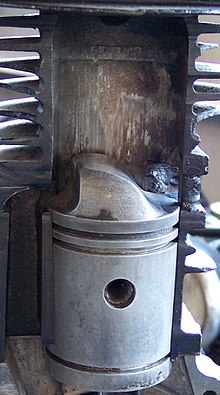Nasal piston
In cross- flow- flushed two-stroke engines , nose pistons are used to keep the fresh gas flow away from the open outlet. The nose sits on the piston crown and deflects the gas flow upwards. The inlet cross-section can be larger than in cross-flow flushed engines with flat pistons.
Even nose pistons cannot prevent fresh gas from escaping into the exhaust at all loads and speeds, and they cause an unfavorable shape of the combustion chamber. After reverse scavenging was developed in the 1920s, cross-scavenged engines lost their importance.
literature
- Jan Drummans: The car and its technology. 1st edition, Motorbuchverlag, Stuttgart, 1992, ISBN 3-613-01288-X
